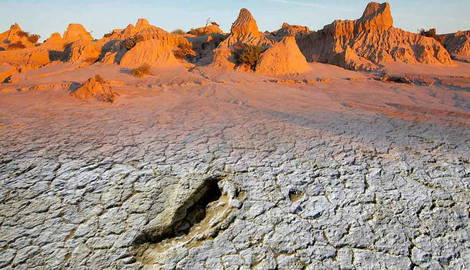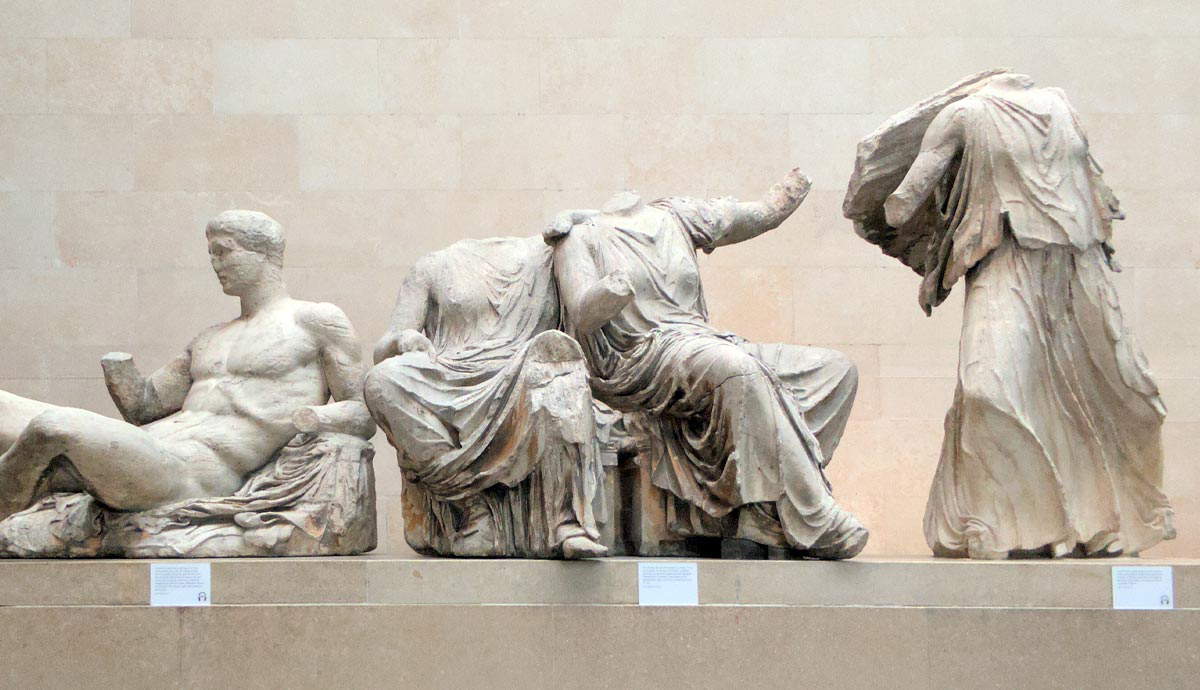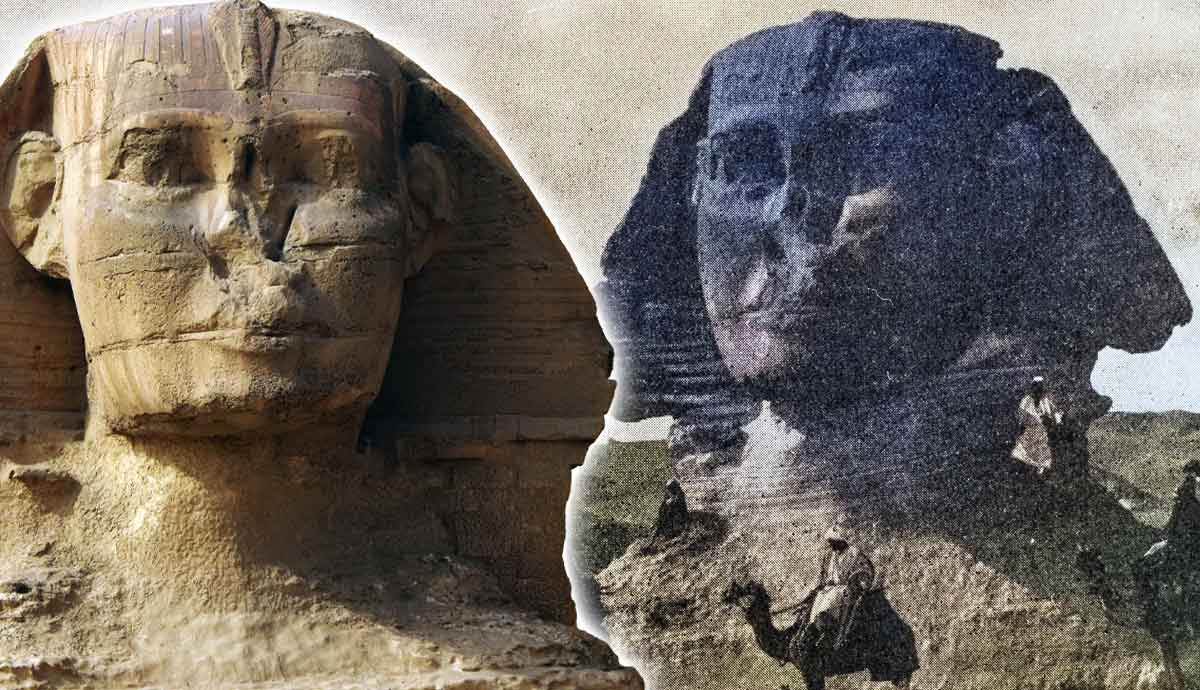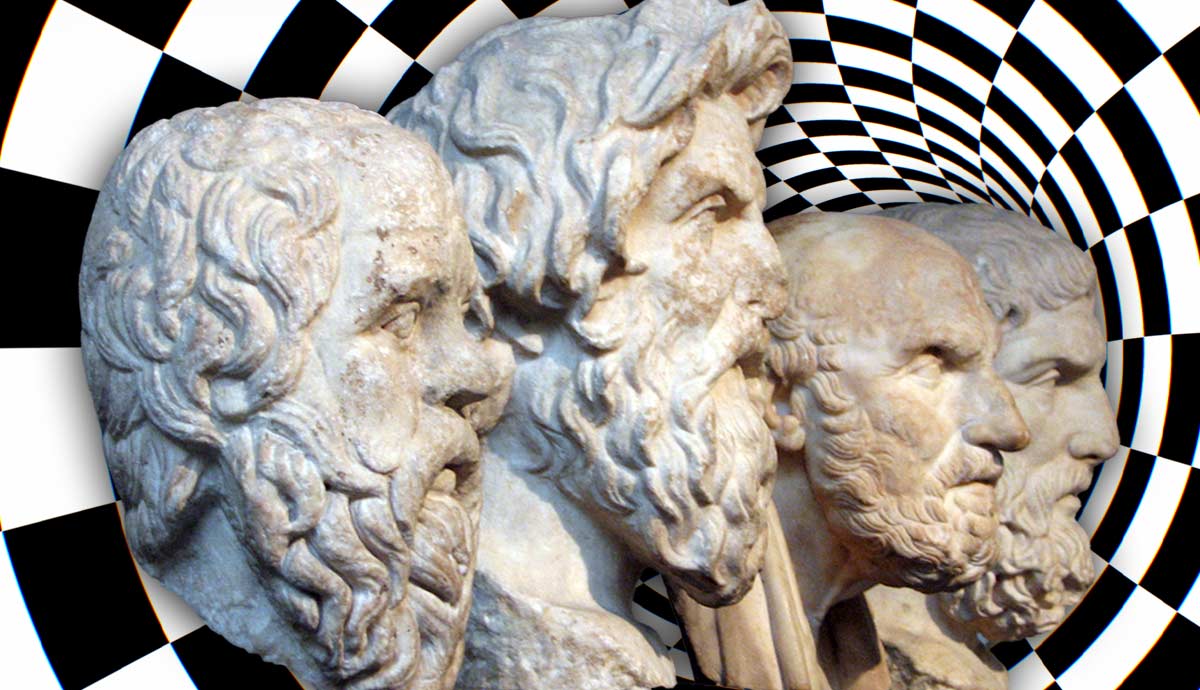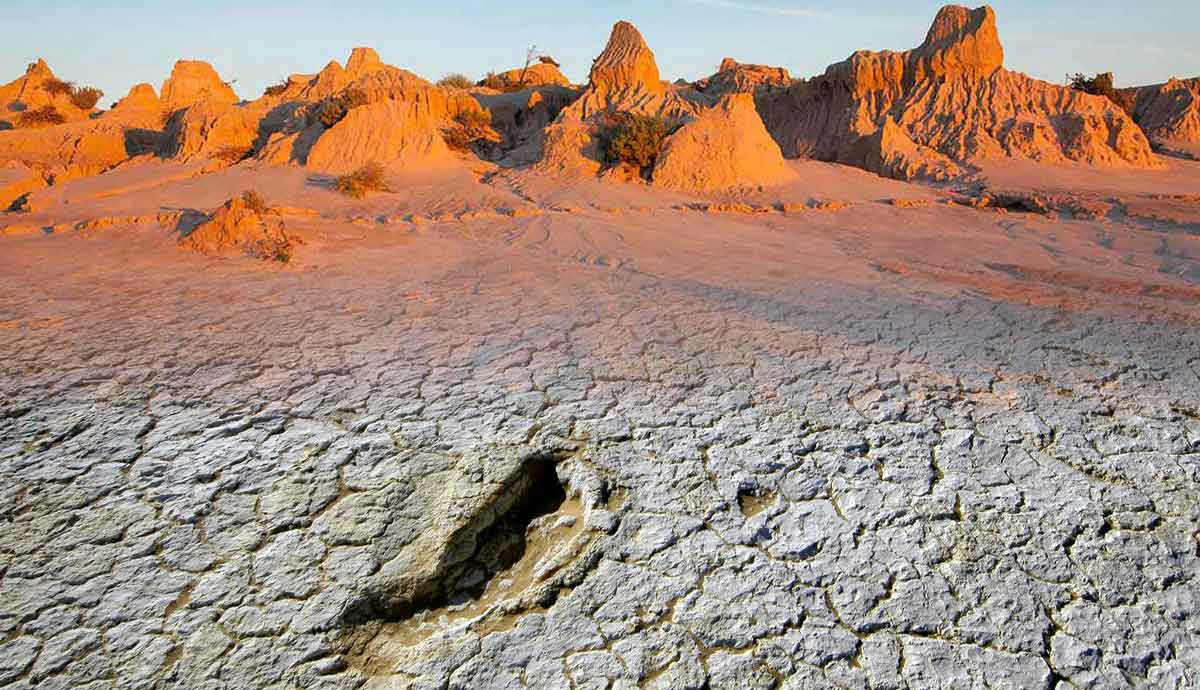
Discovered in 1968 and 1974, the remains of Mungo Lady and Mungo Man revolutionized how the world looked at the history of the Australian continent. Archaeologists and historians found evidence for something they had been speculating about for years—that the ancestors of contemporary Aboriginal Australians moved out of Africa and into Australia between 65,000 and 50,000 years ago. Furthermore, Lake Mungo validated what Mungo’s aboriginal descendants have always maintained: that they are the oldest continuous culture in the world.
Remains at Lake Mungo

The so-called Lake Mungo remains belong to two different people, a man and a woman, and they are the oldest-known burials of Indigenous people on the Australian continent. The man was named Mungo Man, the woman Mungo Lady (or “Mungo Woman”). Far from being a couple, they probably never met each other in their lifetime. Both of them, however, used to live in the region now known as the Willandra Lakes, on the ancestral lands of several Aboriginal nations, the Muthi Muthi, Ngyiampaa, and Barkindji (Paakantji). They drew their last breath between 42,000 and 40,000 years ago.
The first to be discovered was Mungo Lady. Her remains emerged from an eroding dune flanking the dried-out shores of Lake Mungo in July 1968. She was assigned the scientific identifier WLH1, “Willandra Lakes Hominid 1.” The man in charge of studying the Mungo Woman’s skull was paleo-anthropologist Alan Thorne (1939-2012).

He determined that her body had been cremated, in one of the world’s earliest cremations we know of. Her bones were crushed, gathered together, and finally laid to rest in a conical hole. Analysis of Mungo Lady’s remains suggested a complex, far from random, funerary ceremony.
Six years later, on February 26, 1974, Mungo Man (WLH3) was discovered approximately 500 meters to the east of Mungo Lady, on the arid shores of Lake Mungo. Around 170 cm (5 ft 5 in) tall, his almost complete skeleton was found lying in a supine position, his hands folded on his lap. His corpse had been sprinkled with red ochre, a practice widespread among many Indigenous tribes and nations, including the Palawa from Tasmania. Studies of his remains have shown that he suffered from osteoarthritis due to repetitive spear-throwing.
Where Is Lake Mungo?

Lake Mungo is one of the seventeen lakes making up the semi-arid Willandra Lakes region in southwestern New South Wales, about 760 km (472 miles) west of Sydney. In 1981 the region was added to the World Heritage List. It covers 2,400 square kilometers (926 square miles), where dried saltwater lakebeds alternate with a landscape of eroded crescent-shaped dunes (also known as Walls of China), cypress pines, and mallee trees.
Today, the Mungo National Park, managed jointly by the NSW National Parks and Wildlife Service and Traditional Tribal Groups, encompasses 29.9% of the Willandra Lakes Region. The rest of the area comprises several pastoral stations administered by the New South Wales Land and Property Management Authority. When Mungo Lady and Mungo Man were alive, the lakes in the Willandra region were full and intermittently fed by a large river, now known as the Lachlan.

Archaeologists have discovered an impressive trail of footprints in the Willandra Lakes region, imprinted into a mud flat, suggesting that Mungo Lady and Mungo Man were only two of the people gravitating around Lake Mungo. They were likely part of a larger community that heavily relied on the seventeen interconnected lakes for survival, hunting small mammals, feasting on freshwater mussels, and cooking crayfish and waterfowl on stone ovens.
Then, between 19,000 and 18,500 years ago, the Willandra Lakes dried up. Its alkaline soil helped preserve the sandstone tools (likely used for seed grinding), food waste, and hearths, as well as the well-preserved fossils of giant marsupials that archaeologists would find thousands of years later. Today, such findings are considered the earliest evidence of human adaptation outside the African continent.
The Oldest Continuous Culture in the World

In 2003, both Mungo Lady and Mungo Man were dated to 40,000 years old. As of today, Mungo Man remains the oldest example of ochre burial rituals, while Mungo Lady is the oldest known example of cremation. 40,000 years after their deaths, Mungo Man and Mungo Lady have transformed how both non-Indigenous Australians and the world perceive the history of the Australian continent. Their discovery has thus ignited a much-needed reassessment of Australia’s prehistory.
The Mungo remains confirmed what archaeologists and historians have speculated for years, that the ancestors of Aboriginal Australians moved out of Africa and into Australia between 65,000 and 50,000 years ago. Aboriginal people have therefore been living on the Australian continent for at least 65,000 years, as confirmed by the artifacts discovered in the Madjedbebe rock shelter in Mirrarr Country, Northern Arnhem Land, and at Warratyi, in the Northern Flinders Ranges.

On the other hand, the discoveries of Mungo Man and Mungo Lady have confirmed what their descendants have always asserted—that Aboriginal and Torres Strait Islanders have continuously inhabited Australia, and that they are the oldest continuous culture in the whole world. They have indeed been living, surviving, and thriving in what is now Australia for as long as modern populations have been living outside of the African continent.
In triggering a new global understanding of the unique relationship between Aboriginal people and the land, the Lake Mungo discoveries also had the effect of galvanizing the land rights and self-determination movements. Aboriginal claims, now backed by universally accepted scientific evidence, were further legitimized. The discovery at Lake Mungo laid the foundation for a new, cross-cultural research approach involving academics, archaeologists, and Indigenous people and Elders, an approach that is continuously being refined.
The Men Behind the Discovery

The remains of Mungo Man and Mungo Lady were found by Jim Bowler, a postgraduate student in geology at the Australian National University (ANU). Committed to uncovering geological evidence of the climatic changes triggered by the glaciation of Australia during the Pleistocene, he was researching the thirteen once-interconnected ancient lakes in the Willandra region.
Several archaeologists joined forces to excavate the burial of Mungo Lady in 1968, including Welsh-Australian Rhys Jones (1941-2001) and John Mulvaney (1925-2016). Mulvaney, who is widely acknowledged as “the father of Australian archaeology,” returned to Lake Mungo in 1973 with Jim Bowler to lead the excavation that resulted in the discovery of Mungo Man. This excavation is now recognized as the largest ever in the region.

In a recent interview with The Guardian, Bowler recalled that “I was always very much aware of the importance of … Mungo Lady. [But] her remains were highly fragmented – they’d been burnt and they were sitting already exposed – so there was no actual understanding of the environment [at time of burial] … but I always had in the back of my mind that there was more evidence of people and so you keep going on looking.”
In February 2024, 94-year-old Jim Bowler returned to the Willandra Lakes region to celebrate the 50th anniversary of the discovery of Mungo Man and Mungo Lady. He was joined by members of the three (recognized) Traditional Custodians of the region, the Barkindji, Ngyiampaa, and Muthi Muthi. The area was, and remains, “a goldmine for a geologist.”
What to Do With the Remains?

While welcoming the discovery of Mungo Man and Mungo Lady, the Traditional Custodians of the Willandra Lakes region were also deeply upset by archaeologists’ decision to remove their ancestral remains without their consultation, let alone consent. As their remains were secured at ANU, their removal was, in their view, tantamount to theft.
In his 2024 interview with The Guardian, Bowler agreed that by the 1970s “science had been operating on some disgraceful treatment of Indigenous remains. That sense of disrespect had not yet dawned…There at the time was not…a conscious reflection of shame. But it is now seen as a gross misrepresentation of what we should have been doing…We would treat those remains very differently today.’’ After years of heated discussions, Mungo Lady was returned to her descendants in 1992. Mungo Man was repatriated in 2017, along with more than 100 remains found over the years in the Willandra Lakes region.

“We are so grateful he is going to be coming home,” Mutthi Mutthi Elder Mary Pappin observed in 2015, “He’s done his job. It is time for him to go home and rest now.”
For decades, Aboriginal tribes from the Willandra Lakes region opposed plans to re-bury Mungo Man and Mungo Lady in a public ceremony, while others criticized the decision to eventually bury them in a secret location. Many also opposed the construction of monuments on their re-burial site, because, to put it with Barkindji man Michael Young, “the type of monuments some were talking about were ridiculous. It was very colonial…just the idea of a monument goes against our culture.”
In 2022, the remains of Mungo Man and Mungo Lady were moved to a secret place near Lake Mungo, without any markers, monuments, or public ceremonies to celebrate the event.

Jim Bowler expressed himself in favor of a more public, Western-influenced form of preservation, as he believes that neither Mungo Man nor Mungo Lady deserved “to be secretly buried without honour. […] In contrast to the ritual ceremony that was enacted there 40,000 years ago, the secret reburial remains a sad moment.”
The debates surrounding Mungo Man’s and Mungo Lady’s final resting place raise important, although controversial, questions. When it comes to archaeological discoveries, who should have the last say? If there’s one thing that Bowler and Aboriginal Elders agree on, it is the need to start viewing the Mungo remains as a starting point, as a “place of healing.” This can only be achieved through dialogue and education. To put it with Jason Kelly, the grandson of Aboriginal activist Alice Kelly, “We have never come close to realising the potential of Mungo as a place of global cultural and spiritual and human importance.”
